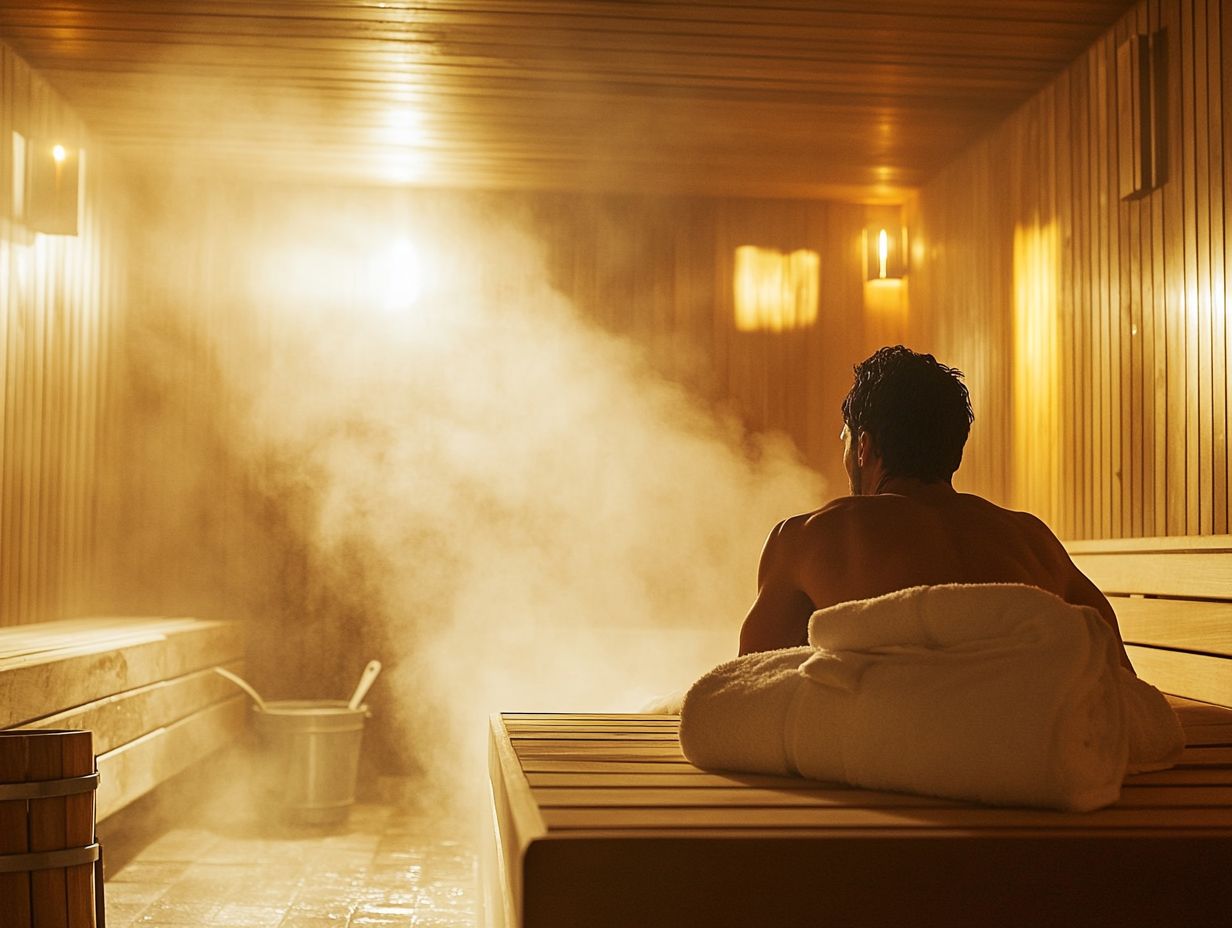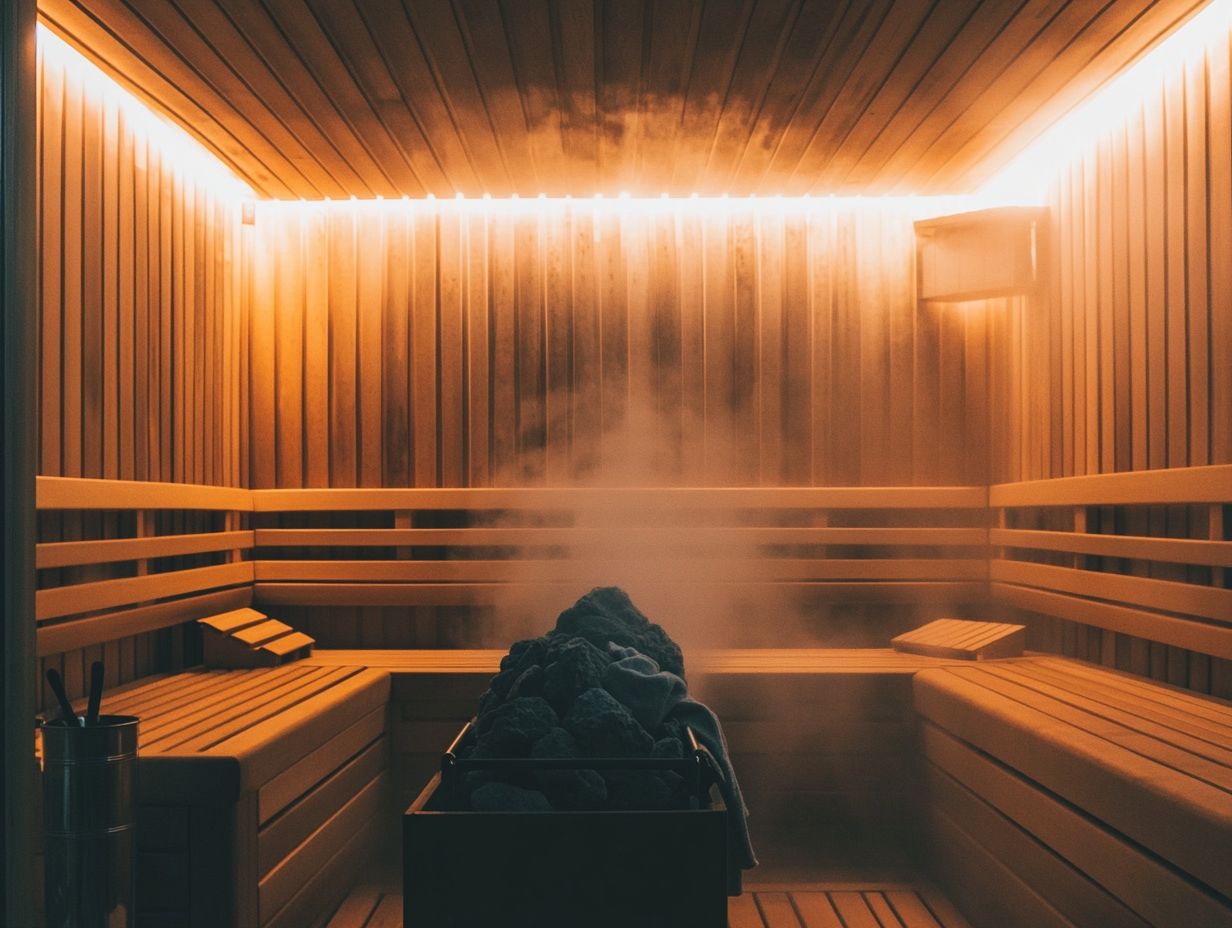Sauna Use After Workouts: Safety Tips
After an intense workout, you may find yourself seeking ways to enhance your recovery. A sauna could be just what you need!
Not only does it soothe those sore muscles, but it also presents a myriad of health benefits that can elevate your post-exercise routine.
This article delves into how sauna types aid muscle recovery. We will outline essential safety precautions to consider, highlight potential risks, and present alternative methods for relaxation.
Whether you re a seasoned fitness enthusiast or just beginning your journey, discover how to maximize your post-workout recovery through the use of a sauna.
Contents
- Key Takeaways:
- The Benefits of Using a Sauna After a Workout
- Safety Precautions to Take
- Potential Risks and How to Avoid Them
- Key Risks of Sauna Use and How to Stay Safe
- Alternatives to Sauna Use After Workouts
- Frequently Asked Questions
- What are the benefits of using a sauna after a workout?
- Is it safe to use a sauna after every workout?
- How long should I wait after working out to use a sauna?
- Are there any safety precautions I should take before using a sauna after a workout?
- Can sauna use after workouts help with weight loss?
- Are there any risks associated with using a sauna after a workout?
Key Takeaways:

- A sauna after your workout helps muscle recovery and brings more benefits.
- Take safety precautions when using a sauna, like staying hydrated and limiting your time inside.
- Be aware of heat-related injuries and consider alternative muscle recovery methods based on your health and fitness levels.
The Benefits of Using a Sauna After a Workout
Using a sauna session after your workout offers many health benefits. These include enhanced muscle recovery, improved heart health, and effective stress management.
Whether you prefer the soothing warmth of an infrared sauna, the humidity of a steam room, the traditional Finnish sauna, or the luxurious Turkish bath, each option provides a unique experience tailored to your preferences while promoting overall well-being.
These high-temperature environments work wonders in alleviating discomfort, chronic pain, and muscle tension. This makes them especially advantageous for athletes aiming to optimize both performance and recovery time.
How Saunas Help with Muscle Recovery
Saunas can be your best ally in muscle recovery. They boost blood circulation to deliver oxygen-rich blood to fatigued muscles and support the healing process.
When you expose yourself to the heat of a sauna, it encourages sweating and helps eliminate toxins. This reduces muscle soreness and accelerates recovery time especially after those intense workouts.
By incorporating heat therapy into your post-workout routine, you not only alleviate discomfort but also enhance your overall recovery process. As your body heats up, your vascular system expands, improving circulation and driving essential nutrients directly to damaged muscles.
This increased blood flow doesn t just aid recovery; it also fosters muscle growth by facilitating a more efficient exchange of metabolic waste removal, keeping stiffness at bay.
When you sweat during your sauna sessions, you help flush out harmful toxins like lactic acid, which can build up after rigorous activities. This promotes better muscle health and supports your long-term fitness goals.
Other Potential Benefits
Your sauna sessions can unlock amazing health benefits! Along with muscle recovery, they can offer improvements in heart health, relief from chronic pain, and even weight loss through increased sweating and relaxation.
Regular sauna use enhances cardiovascular health, reduces joint pain, and effectively manages stress. This transforms sauna sessions into a holistic wellness tool for you.
Numerous studies show that using a sauna can significantly lower blood pressure and improve endothelial function, both critical for maintaining heart health. The heat stimulates the widening of blood vessels, enhancing your blood circulation.
For those grappling with chronic pain conditions like arthritis, the warmth can work wonders. It eases discomfort and fosters mobility by boosting blood flow to those affected areas.
Moreover, sweating isn’t just about feeling refreshed; it aids in detoxification. This allows your body to expel harmful toxins while potentially helping with weight loss by revving up your metabolism.
Regular sauna sessions offer a tranquil environment perfect for relaxation. They help alleviate stress and promote overall mental well-being, making it an invaluable addition to your balanced lifestyle.
Don’t wait! Start adding sauna sessions to your routine for better recovery today!
Safety Precautions to Take
While saunas provide a wealth of health benefits, prioritizing safety precautions is crucial for a truly positive experience. Recognize the risk of dehydration from sweating. Staying hydrated is key.
Follow recommended guidelines for session duration and temperature settings to help you avoid overheating and discomfort while ensuring an enjoyable sauna experience.
General Guidelines for Sauna Use

General guidelines for sauna use emphasize the importance of staying hydrated and ensuring your comfort throughout your sessions, especially in health clubs where facilities can differ. It s essential to drink sports drinks before and after your sauna visit to replenish the fluids lost through sweating.
This effectively minimizes the risk of dehydration and discomfort. Preparing for your sauna experience involves more than just hydration; a thorough shower to cleanse your skin can truly enhance the overall experience.
Starting with a shorter session and gradually increasing the duration allows your body to adapt to the heat comfortably. Opting for breathable attire, like a cotton towel, will promote airflow and help regulate your body temperature.
After your sauna session, take your time cooling down to let your body adjust. Consider following up with a protein-rich snack to replenish your energy. Follow these practical tips now to supercharge your sauna experience and reap maximum benefits!
Specific Tips for Post-Workout Sauna Use
For optimizing your post-workout recovery in the sauna, there are specific strategies that can help you rejuvenate effectively and alleviate muscle tension. It s advisable to wait at least 10-15 minutes after exercising before stepping into the sauna. This allows your body to cool down properly.
Don t forget to hydrate; replenishing the fluids you lost during your workout is crucial. Consider sipping on electrolyte-rich beverages after exercising. This little trick will enhance your rehydration and replenish essential minerals.
Once you’re settled in the sauna, aim for a session of 15 to 20 minutes to maximize the benefits for muscle relaxation and recovery. Alternating between sauna sessions and brief cooldowns is a smart move to avoid overheating and improve muscle circulation.
This thoughtful strategy promotes enhanced recovery and helps reduce soreness, making it an invaluable addition to your athletic regimen.
Potential Risks and How to Avoid Them
Saunas are generally safe for most people, but it s crucial to recognize the potential risks. Heat-related injuries and discomfort can pose challenges, especially for those with chronic conditions.
Understand these risks and follow best practices to minimize adverse effects. Enjoy the numerous benefits sauna sessions can offer.
Heat-Related Injuries and How to Prevent Them
Heat-related injuries can strike if you don t manage your sauna sessions wisely, with dehydration and discomfort being the most prevalent issues you might encounter. To safeguard against these risks, maintaining temperature control, staying well-hydrated, and tuning into your body s signals during your time in the sauna are essential steps.
More serious conditions like heat exhaustion and heat stroke can also develop if you don t take precautions seriously. You might experience symptoms of heat exhaustion such as dizziness, excessive sweating, and fatigue, while heat stroke can escalate to confusion and even loss of consciousness.
To reduce these risks, ensure you re in good health before stepping into the sauna, limit your exposure time, and take breaks as necessary. Proper preparation and awareness play a significant role in creating a safe and enjoyable sauna experience, allowing you to indulge in its relaxing benefits while minimizing potential health hazards.
Key Risks of Sauna Use and How to Stay Safe
Other risks associated with sauna use include the potential to exacerbate existing medical conditions and discomfort for individuals with certain chronic conditions. It’s crucial to consult health recommendations and seek medical advice before incorporating sauna sessions into your routine, especially if you have heart disease or respiratory issues.
Dehydration and heat intolerance are significant challenges, particularly for those unaccustomed to high temperatures. To mitigate these risks, ensure you hydrate adequately before and after your sauna experience while tuning into your body s signals.
Engaging with healthcare professionals can provide personalized insights tailored to your unique health status. If you re pregnant, elderly, or on medication, approach sauna use with caution and seek guidance, as your needs may differ.
You ll absolutely love the relaxation benefits a sauna offers just prioritize your health first!
Alternatives to Sauna Use After Workouts

For those who find themselves unable to indulge in a sauna after workouts, several highly effective alternatives can equally promote muscle recovery and relaxation.
Try these exciting recovery methods:
- Cold therapy
- Massage
- Targeted stretching
Each of these can significantly enhance your recovery process. Remember, staying hydrated is essential in every recovery strategy you choose to implement.
Other Methods for Muscle Recovery and Relaxation
Other methods for muscle recovery and relaxation to consider include cold therapy, massage, and heat therapy, each offering distinct benefits tailored to your individual needs and preferences. Cold therapy is excellent for reducing inflammation, while massage promotes blood circulation. Heat therapy akin to enjoying a sauna helps with muscle relaxation and relieving tension.
Taking the time to explore each option can reveal their vital roles in your recovery journey. Cold therapy, often applied through ice packs or cryotherapy, constricts blood vessels and decreases metabolic activity, effectively reducing swelling and pain. On the flip side, massage enhances circulation by boosting blood flow to your muscles, helping you recover more quickly after exercise.
Meanwhile, heat therapy whether through warm baths or heating pads encourages blood flow and improves flexibility, perfectly complementing sauna sessions by further relaxing tight muscles. These methods don t just stand alone; they can be strategically combined to elevate your overall muscle health and well-being.
Considering Individual Health and Fitness Levels
Considering your individual health and fitness levels is essential when selecting recovery strategies after workouts, as your needs may vary significantly. Factors such as age, fitness level, and any underlying medical conditions should be assessed to determine the most suitable methods for muscle tension relief and hydration.
If you engage in high-intensity training, you might require more robust recovery modalities, including advanced techniques like alternating hot and cold baths or compression therapy. On the other hand, if your fitness level is lower, gentle stretching or simply taking a rest could serve you better.
Personal preferences play a significant role in how effective these recovery strategies can be. You might find yoga to be a soothing way to relax, while someone else may swear by foam rolling. Listening to your body is crucial, and adapting your recovery methods accordingly promotes better outcomes and enhances your overall workout experience, ensuring a sustainable path to fitness.
Frequently Asked Questions
What are the benefits of using a sauna after a workout?
Curious about what a sauna can do for you after that workout? Sauna use after a workout has several benefits including muscle relaxation, improved blood flow, detoxification, and stress relief. It can also help with post-workout muscle soreness.
Is it safe to use a sauna after every workout?

It is generally safe to use a sauna after a workout. However, listen to your body and don’t overdo it. Skip the sauna session if you feel lightheaded, dizzy, or nauseous.
How long should I wait after working out to use a sauna?
Wait at least 5-10 minutes after your workout before using a sauna. This allows your body to cool down and helps prevent overheating.
Are there any safety precautions I should take before using a sauna after a workout?
Stay hydrated! Drink plenty of water before and after your sauna session. If you have any injuries or medical conditions that might worsen with heat, avoid the sauna.
Can sauna use after workouts help with weight loss?
Using a sauna can help with weight loss by promoting sweating and removing toxins. Remember, it should complement a healthy diet and regular exercise, not replace them.
Are there any risks associated with using a sauna after a workout?
While there are benefits, be cautious about how long you stay in the sauna. Overheating can cause dehydration, dizziness, or even fainting. Properly cool down and rehydrate afterward!






